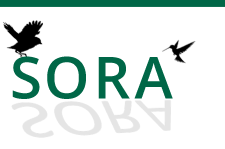Abstract
Con el objeto de realizar un seguimiento a largo plazo de las poblaciones de aves acuáticas en Venezuela, se ha llevado a cabo de forma consecutiva el Censo Neotropical de Aves Acuáticas de Venezuela (CNAAV) desde hace seis años. En este trabajo se presentan los resultados del CNAAV 2012. Siguiendo la misma metodología de años anteriores, se realizaron dos conteos, uno en febrero y otro en julio. Se censaron siete estados y 33 localidades, con la participación de 41 censistas voluntarios. Se registraron 70 especies, 69 en febrero y 56 en julio, pertenecientes a 20 familias, obteniéndose un total de 311.703 individuos, 300.833 en febrero y 10.870 en julio. Las familias con mayor riqueza fueron Ardeidae, Scolopacidae y Laridae, mientras que las de mayor abundancia fueron Phoenicopteridae y Phalacrocoracidae. Se observaron 43 especies residentes, siete residentes con poblaciones que migran y 21 migratorias neárticas. Por segundo año consecutivo hubo abundantes registros del Aruco Anhima cornuta en los Humedales de San Pablo de Urama (Carabobo). Asimismo, se observaron por primera vez al Pato Cuchara Cochlearius cochlearius y la Tigana Eurypyga helias. La abundancia de varias especies fue menor a la registrada en censos anteriores, así como la ausencia total de otras, entre ellas el Tarotaro Cercibis oxycerca y la Cotara Caracolera Aramides cajaneus. Esto resulta preocupante y remarca la importancia del CNAAV como herramienta a largo plazo para detectar y entender los factores que generan las fluctuaciones poblacionales en las aves acuáticas en nuestro país. Sin embargo, la falta de recursos financieros entre otros factores hace cada vez más difícil mantener esta iniciativa.
The Venezuelan Neotropical Waterbird Census (CNAAV), aiming at the long term monitoring of waterbird populations, has been consistently carried out for the last six years in the country. Here we present the results of the CNAAV 2012. As in previous years, there were two bird counts in 2012: February and July. We surveyed 33 localities in seven states with the participation of 41 volunteers. A total of 311.703 individuals were recorded (300.833 in February, 10.870 in July), belonging to 70 species (69 February, 56 July) and 20 families. Families Ardeidae, Scolopacidae and Laridae showed the higher number of species, but Phoenicopteridae and Phalacrocoracidae were the most abundant. We recorded 43 resident species, 21 nearctic migrants, and seven resident species that display local movements. For the second consecutive year, numerous individuals of the Horned Screamer Anhima cornuta were recorded in the wetlands of San Pablo de Urama (Carabobo state). The Boat-Billed Heron Cochlearius cochlearius and the Sunbittern Eurypyga helias were recorded for the first time after several census years. There was a decrease in the abundance of some species, while others, such as the Sharp-tailed Ibis Cercibis oxycerca and the Gray-necked Wood-Rail Aramides cajaneus, were not recorded at all. These results increase our conservation concerns, and remark the importance of the CNAAV as a long term tool to assess waterbird population fluctuations and shed light on the possible factors that can be driving the processes. Unfortunately, low financial support, among others, threatens the continuity of the program.
Creative Commons License
Recommended Citation
Sainz-Borgo, Cristina
(2013)
"Censo Neotropical de aves acuáticas en Venezuela 2012 / Neotropical Waterbird Census in Venezuela 2012,"
Revista Venezolana de Ornitología: Vol. 3
:
Iss.
1
, Article 2.
Available at:
https://digitalcommons.usf.edu/rvo/vol3/iss1/2

